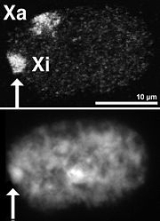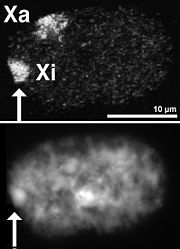
Barr body
Encyclopedia


X chromosome
The X chromosome is one of the two sex-determining chromosomes in many animal species, including mammals and is common in both males and females. It is a part of the XY sex-determination system and X0 sex-determination system...
in a female somatic cell, rendered inactive in a process called lyonization, in those species (including humans) in which sex is determined by the presence of the Y
XY sex-determination system
The XY sex-determination system is the sex-determination system found in humans, most other mammals, some insects and some plants . In this system, females have two of the same kind of sex chromosome , and are called the homogametic sex. Males have two distinct sex chromosomes , and are called...
or W
ZW sex-determination system
The ZW sex-determination system is a system that determines the sex of offspring in birds, some fish and crustaceans such as the giant river prawn, some insects , and some reptiles, including Komodo dragons...
chromosome
Chromosome
A chromosome is an organized structure of DNA and protein found in cells. It is a single piece of coiled DNA containing many genes, regulatory elements and other nucleotide sequences. Chromosomes also contain DNA-bound proteins, which serve to package the DNA and control its functions.Chromosomes...
rather than the diploidy of the X or Z. The Lyon hypothesis states that in cells with multiple X chromosome
X chromosome
The X chromosome is one of the two sex-determining chromosomes in many animal species, including mammals and is common in both males and females. It is a part of the XY sex-determination system and X0 sex-determination system...
s, all but one are inactivated during mammalian embryogenesis
Embryogenesis
Embryogenesis is the process by which the embryo is formed and develops, until it develops into a fetus.Embryogenesis starts with the fertilization of the ovum by sperm. The fertilized ovum is referred to as a zygote...
. This happens early in embryo
Embryo
An embryo is a multicellular diploid eukaryote in its earliest stage of development, from the time of first cell division until birth, hatching, or germination...
nic development at random in mammal
Mammal
Mammals are members of a class of air-breathing vertebrate animals characterised by the possession of endothermy, hair, three middle ear bones, and mammary glands functional in mothers with young...
s, except in marsupial
Marsupial
Marsupials are an infraclass of mammals, characterized by giving birth to relatively undeveloped young. Close to 70% of the 334 extant species occur in Australia, New Guinea, and nearby islands, with the remaining 100 found in the Americas, primarily in South America, but with thirteen in Central...
s and in some extra-embryonic tissues of some placental mammals, in which the father's X chromosome is always deactivated.
In men and women with more than one X chromosome, the number of Barr bodies visible at interphase is always one less than the total number of X chromosomes. For example, men with a 47,XXY karyotype
Karyotype
A karyotype is the number and appearance of chromosomes in the nucleus of an eukaryotic cell. The term is also used for the complete set of chromosomes in a species, or an individual organism.p28...
have a single Barr body, whereas women with a 47,XXX karyotype
Karyotype
A karyotype is the number and appearance of chromosomes in the nucleus of an eukaryotic cell. The term is also used for the complete set of chromosomes in a species, or an individual organism.p28...
have two Barr bodies. Barr bodies can be seen on the nucleus of neutrophils
Neutrophil granulocyte
Neutrophil granulocytes are the most abundant type of white blood cells in mammals and form an essential part of the innate immune system. They are generally referred to as either neutrophils or polymorphonuclear neutrophils , and are subdivided into segmented neutrophils and banded neutrophils...
.
Mechanism
A normal humanHuman
Humans are the only living species in the Homo genus...
female has only one Barr body per somatic cell
Somatic cell
A somatic cell is any biological cell forming the body of an organism; that is, in a multicellular organism, any cell other than a gamete, germ cell, gametocyte or undifferentiated stem cell...
, while a normal human male has none.
Mammalian X-chromosome inactivation is initiated from the X inactivation centre or Xic, usually found near the centromere
Centromere
A centromere is a region of DNA typically found near the middle of a chromosome where two identical sister chromatids come closest in contact. It is involved in cell division as the point of mitotic spindle attachment...
. The center contains twelve gene
Gene
A gene is a molecular unit of heredity of a living organism. It is a name given to some stretches of DNA and RNA that code for a type of protein or for an RNA chain that has a function in the organism. Living beings depend on genes, as they specify all proteins and functional RNA chains...
s, seven of which code for protein
Protein
Proteins are biochemical compounds consisting of one or more polypeptides typically folded into a globular or fibrous form, facilitating a biological function. A polypeptide is a single linear polymer chain of amino acids bonded together by peptide bonds between the carboxyl and amino groups of...
s, five for untranslated RNA
RNA
Ribonucleic acid , or RNA, is one of the three major macromolecules that are essential for all known forms of life....
s, of which only two are known to play an active role in the X inactivation process, Xist and Tsix. The centre also appears to be important in chromosome counting: ensuring that random inactivation only takes place when two or more X-chromosomes are present. The provision of an extra artificial Xic in early embryogenesis
Embryogenesis
Embryogenesis is the process by which the embryo is formed and develops, until it develops into a fetus.Embryogenesis starts with the fertilization of the ovum by sperm. The fertilized ovum is referred to as a zygote...
can induce inactivation of the single X found in male cells.
The roles of Xist and Tsix appear to be antagonistic. The loss of Tsix expression on the future inactive X chromosome results in an increase in levels of Xist around the Xic. Meanwhile, on the future active X Tsix levels are maintained; thus the levels of Xist remain low. This shift allows Xist to begin coating the future inactive chromosome, spreading out from the Xic. In non-random inactivation this choice appears to be fixed and current evidence suggests that the maternally inherited gene
Gene
A gene is a molecular unit of heredity of a living organism. It is a name given to some stretches of DNA and RNA that code for a type of protein or for an RNA chain that has a function in the organism. Living beings depend on genes, as they specify all proteins and functional RNA chains...
may be imprinted.
It is thought that this constitutes the mechanism of choice, and allows downstream processes to establish the compact state of the Barr body. These changes include histone
Histone
In biology, histones are highly alkaline proteins found in eukaryotic cell nuclei that package and order the DNA into structural units called nucleosomes. They are the chief protein components of chromatin, acting as spools around which DNA winds, and play a role in gene regulation...
modifications, such as histone H3 methylation
Methylation
In the chemical sciences, methylation denotes the addition of a methyl group to a substrate or the substitution of an atom or group by a methyl group. Methylation is a form of alkylation with, to be specific, a methyl group, rather than a larger carbon chain, replacing a hydrogen atom...
and histone H2A ubiquitination, as well as direct modification of the DNA
DNA
Deoxyribonucleic acid is a nucleic acid that contains the genetic instructions used in the development and functioning of all known living organisms . The DNA segments that carry this genetic information are called genes, but other DNA sequences have structural purposes, or are involved in...
itself, via the methylation of CpG site
CpG site
CpG sites or CG sites are regions of DNA where a cytosine nucleotide occurs next to a guanine nucleotide in the linear sequence of bases along its length. "CpG" is shorthand for "—C—phosphate—G—", that is, cytosine and guanine separated by only one phosphate; phosphate links any two nucleosides...
s. These changes help inactivate gene
Gene
A gene is a molecular unit of heredity of a living organism. It is a name given to some stretches of DNA and RNA that code for a type of protein or for an RNA chain that has a function in the organism. Living beings depend on genes, as they specify all proteins and functional RNA chains...
expression on the inactive X-chromosome and to bring about its compaction to form the Barr body.
Further reading
- Alberts,B., Johnson,A., Lewis,J., Raff,M., Roberts,K., Walter,P., (2002), Molecular Biology of the Cell, Fourth Edition, (428-429) Garland Science, 0-8153-4072-9 (Web Edition, Free access)
- Turnpenny & Ellard: Emery's Elements of Medical Genetics 13E (http://www.studentconsult.com/content/default.cfm?ISBN=9780702029172&ID=HC006029)

